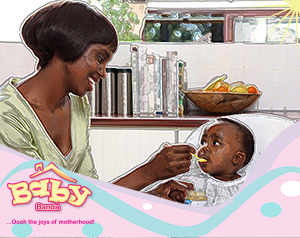[wpmem_logged_out]
Login to view content
[/wpmem_logged_out][wpmem_form login]
- Start by offering food 2-3 times a day.
- To ensure that your baby gets enough iron, aim for at least 120 mL (8 tbsp) of iron-fortified cereal by age 9 months. In addition, offer animal sources of iron which are better absorbed by babies e.g. chicken and fish.
- Give dairy (milk) feeds separately from foods rich in iron, as milk interferes with the absorption of iron. Preferably, give dairy products two (2) hours after consumption of iron-rich foods.
- Give your baby no more than 2 oz (60 ml) of water at one time and no more than 4 oz (125 ml) of water a day. Too much water will fill your baby up. The only bottled waters suitable for babies are non-carbonated natural spring water from underground springs and non-carbonated treated water with low mineral content. Bottled water should have less than 100 mg/L of total dissolved solids (TDS). Otherwise, just boil or filter tap water and serve.
- Breast Milk continues to the main food for the baby and that is why the introduction of new foods is referred to as ‘complementary feeding”. Give at least 500ml of breast milk or infant formula per day. You can also offer natural yoghurt from six (6) months. However, avoid cow milk as the intestines of some babies may bleed if they drink cow’s milk during their first year of life. This slow leakage of blood from the lining of the intestine can cause iron-deficiency anaemia. For this reason, paediatricians no longer recommend giving cow’s milk to children during their first year of life. Cow milk‘s minerals are much higher (typically 2–3 times) than in human milk, baby, therefore, gets too much protein, sodium, and potassium. These levels may be too high for the infant’s system to handle.
[/wpmem_form]













